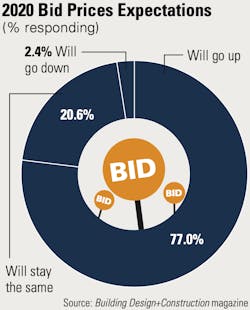Amid the ongoing trade wars, weakening business confidence, and emerging consumer concerns, some industry economists called for a slowdown of the red-hot U.S. nonresidential construction market by the end of 2019. Yet, despite a softening of select building sectors—including religious facilities and retail buildings—the overall nonresidential construction market continues to hum right along at a near-record pace.
As of September 2019, construction spending across all nonresidential building sectors totaled $775.63 billion (seasonally adjusted annual rate), just 1.5 percent off the all-time high of $782.95 billion, according to the U.S. Census Bureau. This ongoing growth “reflects the underlying strength of the economy, even this late in the business cycle,” said Kermit Baker, chief economist of the American Institute of Architects, in the AIA’s latest Consensus Construction Forecast. For this report, Baker collects and analyzes construction spending forecasts from eight reputable economists. Collectively, the group called for 3.8 percent growth in 2019 and a 2.4-percent uptick in 2020—not the economic recession that some feared would hit the U.S. construction market.
Public safety, education, healthcare, and office buildings will lead the way in 2020, with a high of 5.9 percent growth in public safety buildings, followed by 4.4 percent growth for education-related facilities and a 3.7 percent expansion in spending for healthcare buildings, according to the AIA report.
Are AEC firms as confident as industry economists? Yes and no, according to an October 2019 survey of 207 architects, engineers, contractors, and building owners/developers by Building Design+Construction. On one hand, more than half of the responding firms are expecting revenue growth in 2019 (58 percent of firms are calling for increased revenue) and 2020 (53 percent). On the flip side, a larger share of firms is calling for declining revenue in 2020, when compared to BD+C’s industry forecast survey one year ago (14.3 percent vs. 8.7 percent in the 2018 survey).
Twenty-one months into the Trump Administration’s international trade war, it appears that AEC firms are starting to see negative effects from the ongoing tariffs on steel, aluminum, lumber, and other common construction materials from select countries. More than a quarter of respondents cited “business impact from Presidential election” as a primary concern heading into 2020, up from 19 percent of the responding firms from last year’s survey. The most commonly cited concern was “general economic conditions (i.e., recession),” “competition from other firms,” and “price increases.”
To help keep their project pipelines full through 2020, AEC firms are focusing on a number of business development strategies heading into next year, including “increase investments in technology” and “make selective hires to increase competitiveness.” Others are “increase marketing/public relations efforts,” “create new service or business opportunity,” and “increase staff training or education to enhance competitiveness.”
--Barista is editorial director of Building Design+Construction






